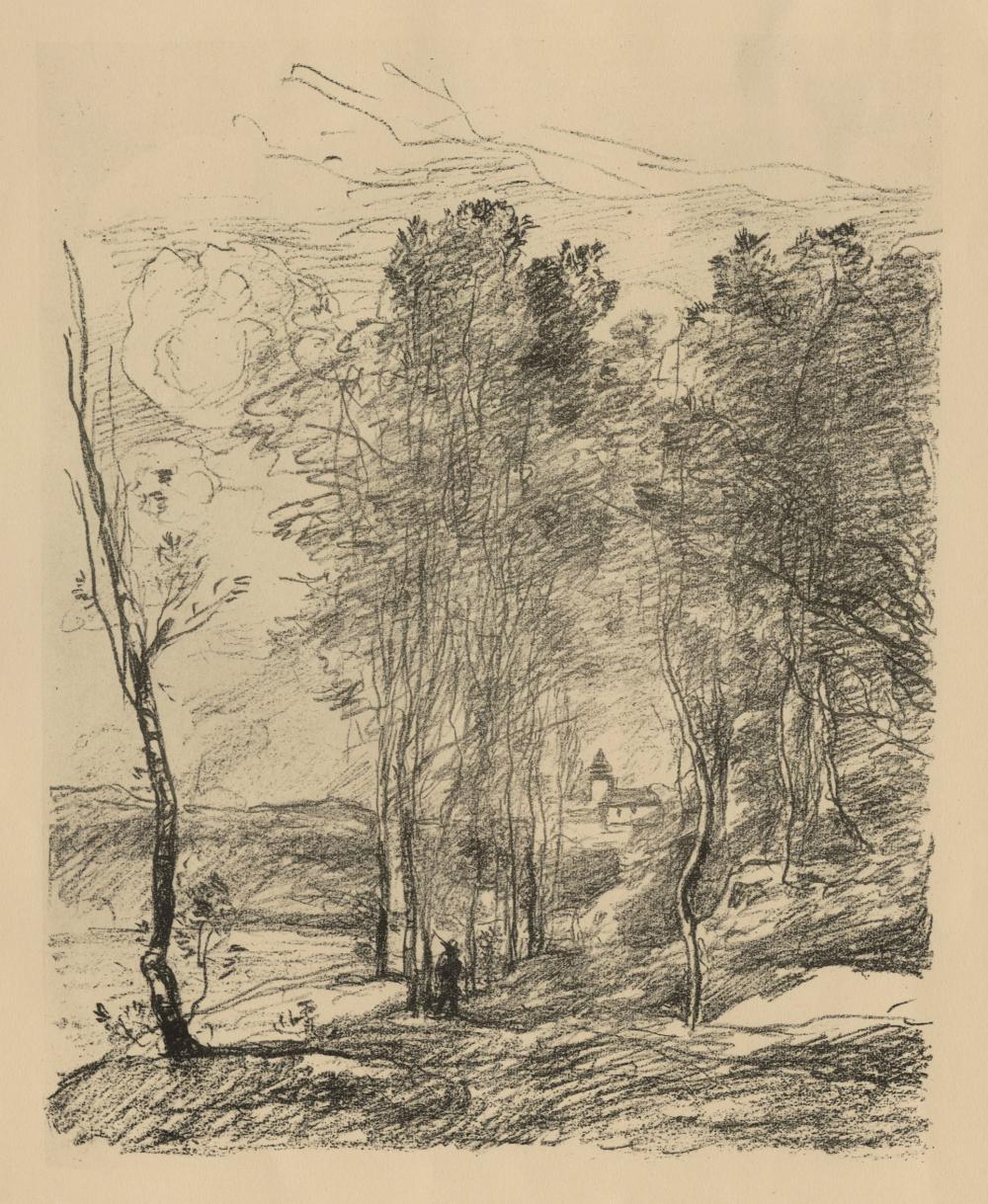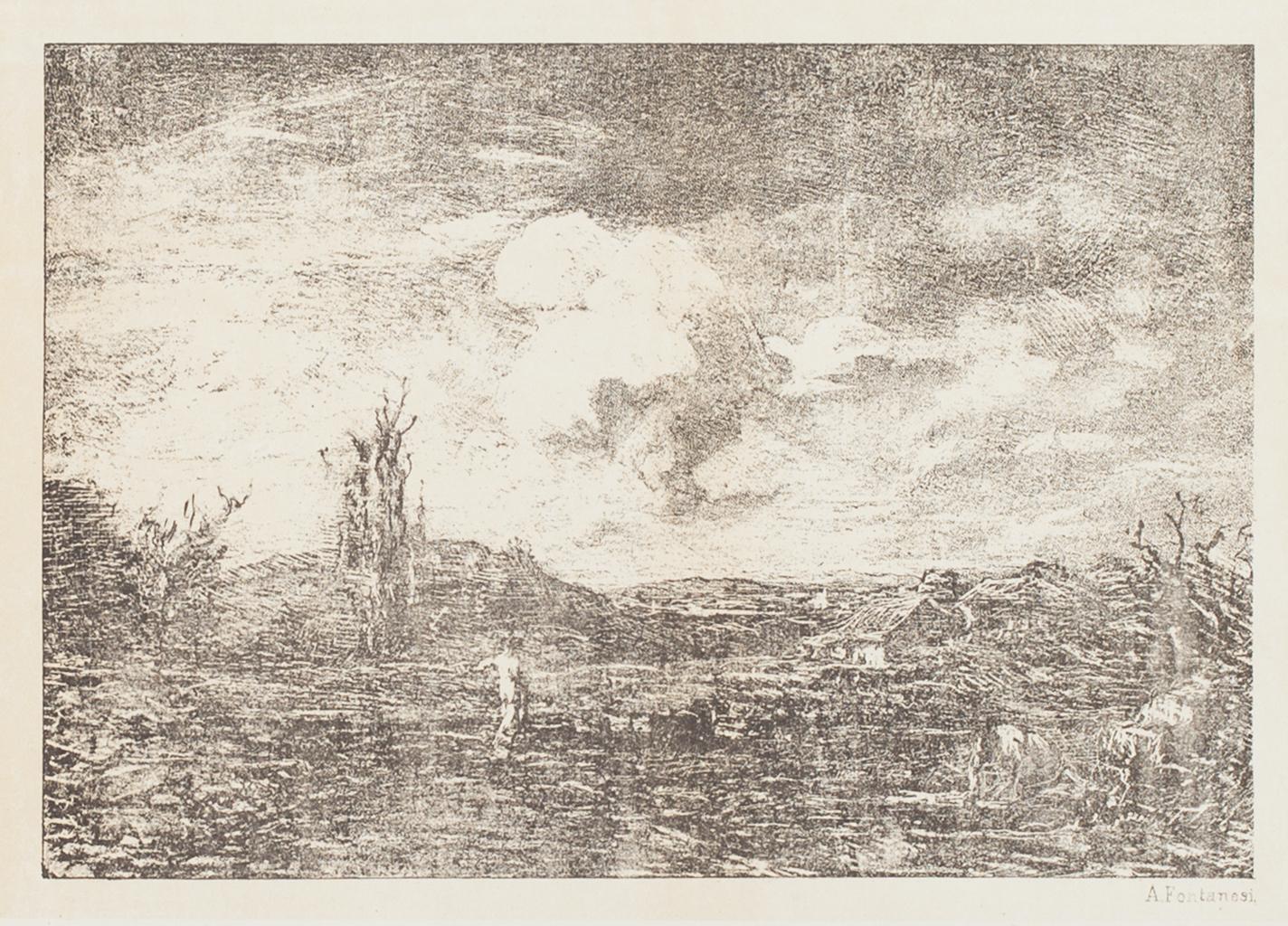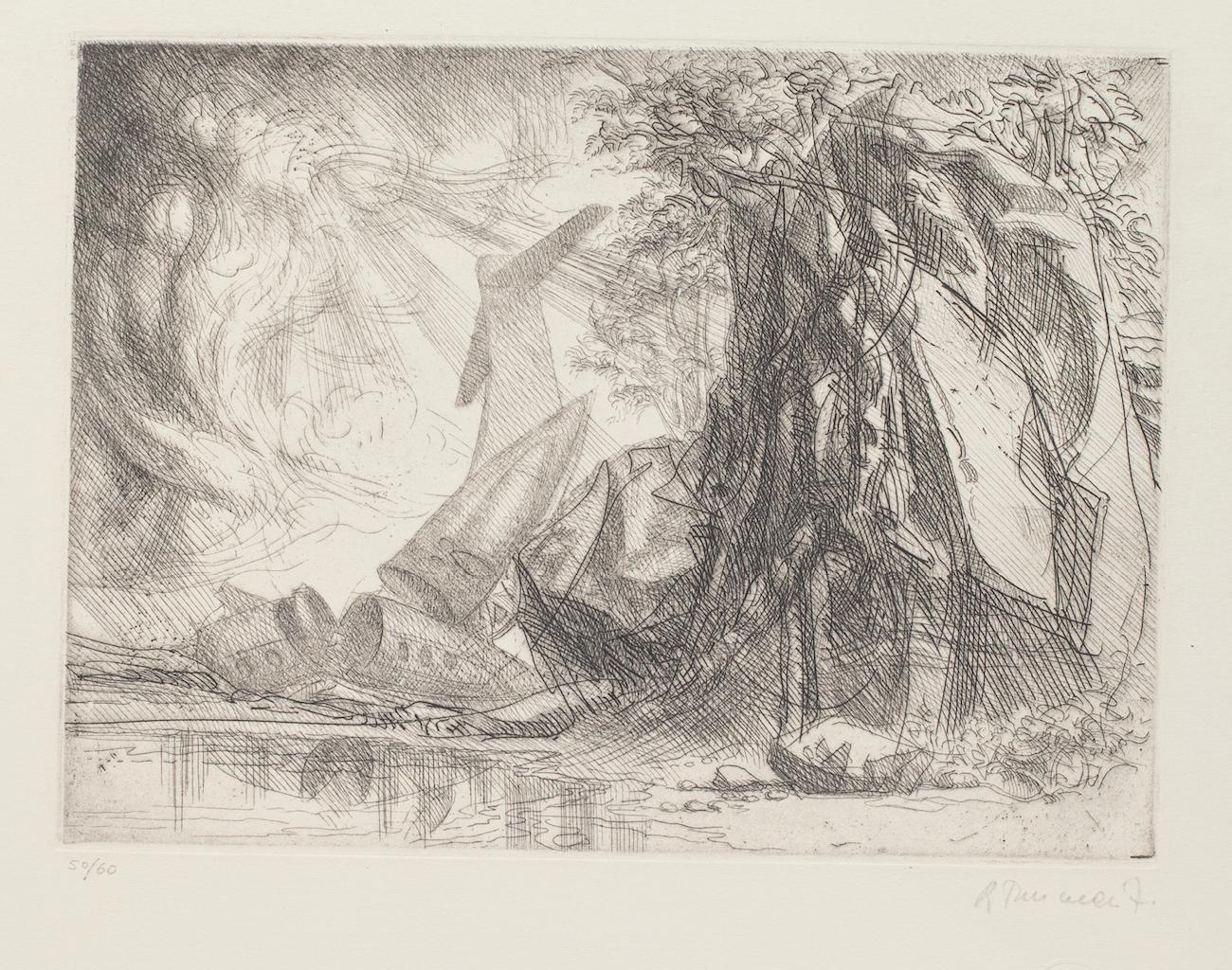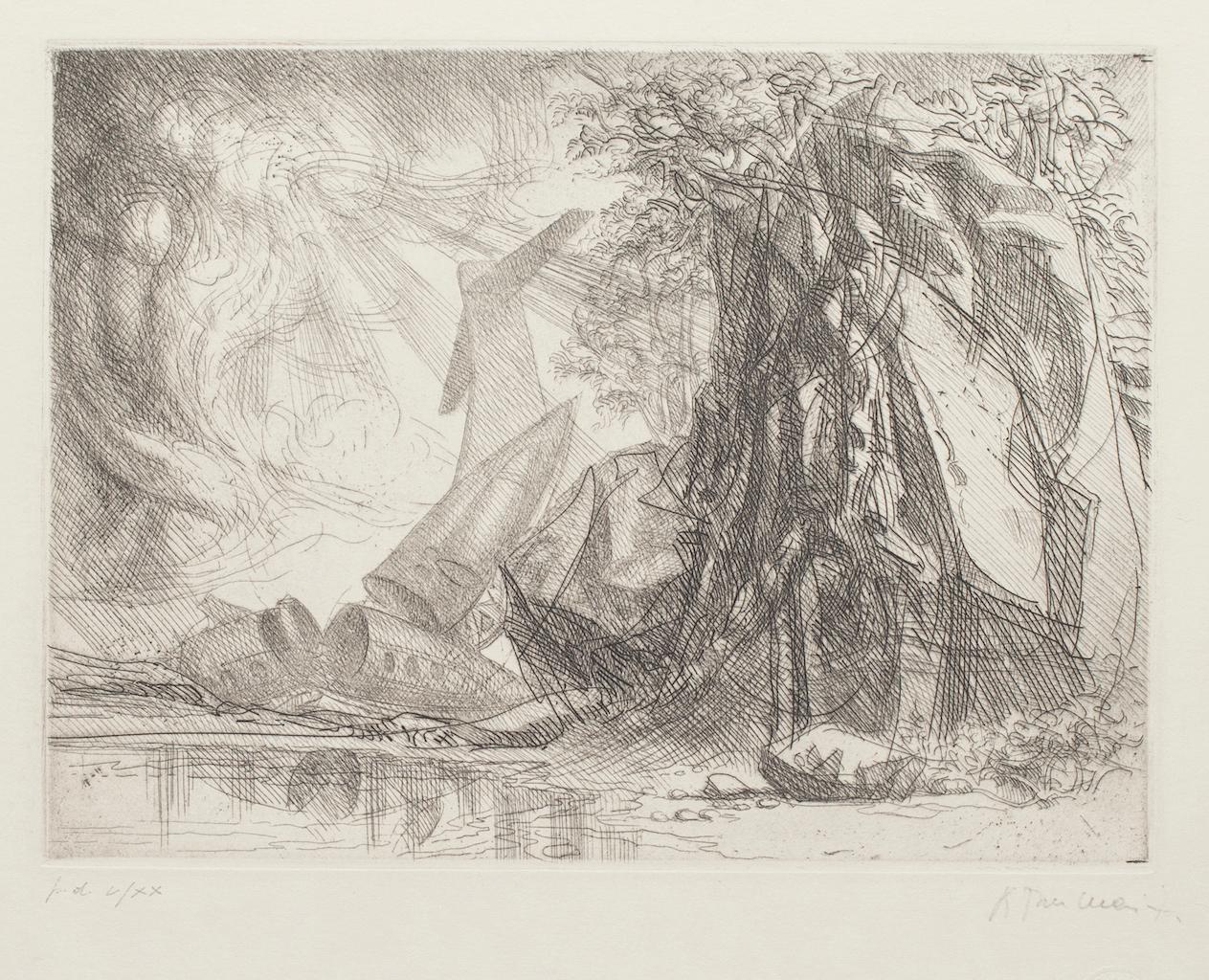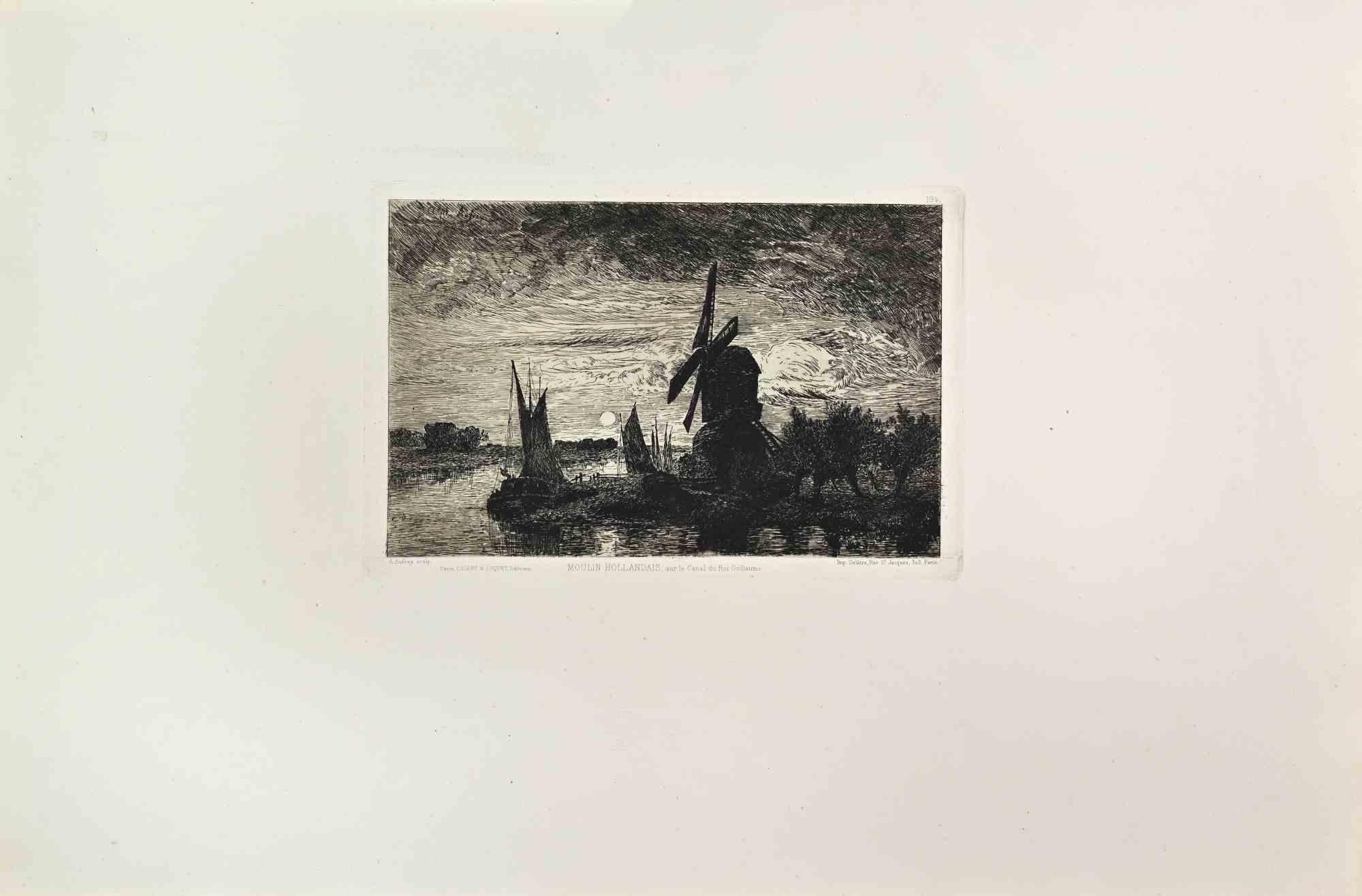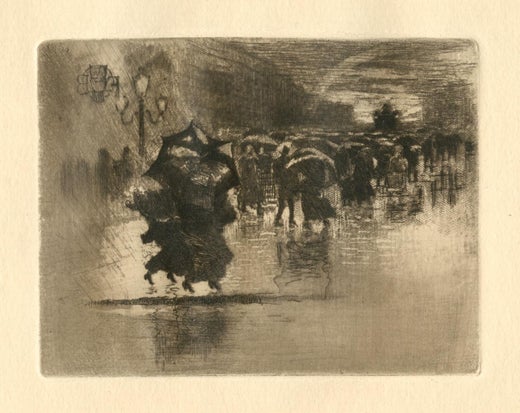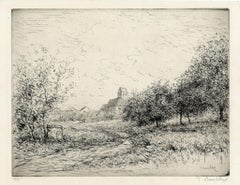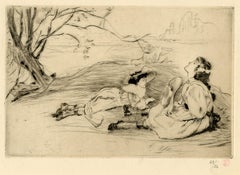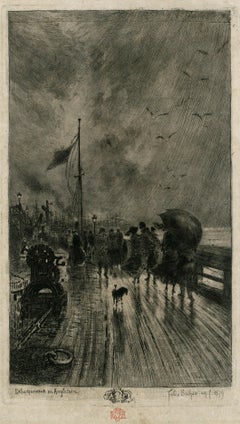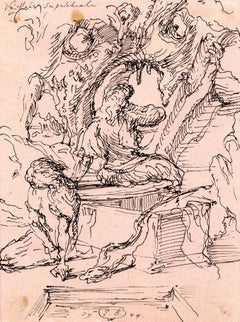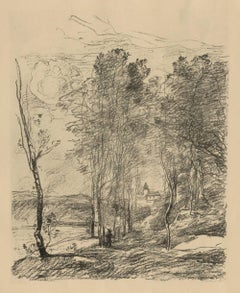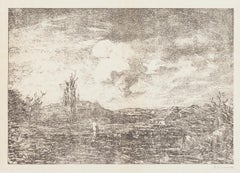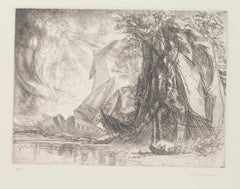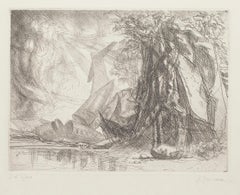Items Similar to L’Angelus (The Bell Tower)
Want more images or videos?
Request additional images or videos from the seller
1 of 6
Félix Hilaire BuhotL’Angelus (The Bell Tower)c. 1876
c. 1876
$500
£378.84
€434.69
CA$703.58
A$773.43
CHF 406.48
MX$9,392.24
NOK 5,070.72
SEK 4,804.15
DKK 3,244.23
About the Item
L’Angelus (The Bell Tower)
etching & drypoint, c. 1876
Signed in the plate with the artist's initials (see photo)
Condition: Excellent
Image/Plate size: 5 7/8 x 4 1/4 inches
Sheet size: 7 3/8 x 5 1/2 inches
Reference: Bourcard/Goodfriend 72 iii/IV, final state before cancelation of the plate
This image is the artist’s homage to Corot.
Félix-Hilaire Buhot
French, 1847 - 1898
Among the most original prints made in France during the last quarter of the nineteenth century are those by Félix Buhot. Born in 1847 in the small Normandy town of Valognes, in northern France, Buhot moved to Paris in 1865, where a year later he enrolled in the École des Beaux-Arts, studying painting and drawing under various artists. Buhot first learned to etch in about 1873, producing his first etching later that year and quickly establishing himself as a successful printmaker. The young artist made his living by decorating fans and illustrating lithographic sheet music. Buhot lived and worked most of his life in Paris, with frequent visits back to northern France and extended trips to England where he met his wife, Henrietta Johnston, whom he married in 1881. By 1892 Buhot had ceased making prints, and in 1898, after suffering prolonged bouts of deep depression, he died at the age of fifty-one.
Along with Edgar Degas and Camille Pissarro, Félix Buhot numbers among the most experimental printmakers of his day. In exploring the unique aspects of etching, he developed an approach to printmaking that was very painterly; in fact he called his prints "paintings on copper." A true printmaker's printmaker, Buhot delighted in all the technical variables and regularly combined multiple processes to produce a single print: he achieved even greater tonal variation by employing the more traditional techniques of etching, drypoint, and aquatint along with several less familiar methods. Unlike many contemporary printmakers who disliked photography, Buhot heartily embraced the medium and used it as a creative aid. He also used different inks and papers for varied effects. His most original contribution to the history of printmaking is a device he termed marges symphoniques (symphonic margins): by amplifying the main subject, such illustrations became an integral part of the print.
In his many prints of city views and seascapes, Buhot was intent on creating a specific atmosphere, especially the effects of weather such as rain, snow, mist, and fog. He turned to his immediate neighborhood in and around the boulevard de Clichy in Montmartre, Paris, for inspiration for his prints of everyday city life. Buhot delighted in portraying the varied street life of the vibrant capital city not only in different seasons (Winter in Paris, 1879) but also in moments of public display, from a festive holiday celebration (National Holiday on the Boulevard de Clichy, 1878) to a somber death observance (Funeral Procession on the Boulevard de Clichy, 1887). His city views also include London scenes (Westminster Palace and Westminster Bridge, both of 1884). And Buhot's love for the sea is evidenced in the many prints exploring its ever-changing atmospheric conditions and moods. Buhot's boat trips to England inspired two of his most characteristic prints, A Pier in England and Landing in England, both from 1879.
With his experimental printmaking techniques, Buhot became one of the best-known, admired, and collected printmakers of his day. He achieved success for his prints at the annual Salons between 1875 and 1886, and a number of his works were published in leading periodicals and books. He also found critical acclaim and support for his prints in the United States, especially after his first one-man exhibition organized by the New York print dealer Frederick Keppel in 1888.
Courtesy: National Gallery of Art, Washington, D. C.
- Creator:Félix Hilaire Buhot (1847 - 1898, French)
- Creation Year:c. 1876
- Dimensions:Height: 5.88 in (14.94 cm)Width: 4.25 in (10.8 cm)
- Medium:
- Movement & Style:
- Period:
- Condition:
- Gallery Location:Fairlawn, OH
- Reference Number:Seller: FA105221stDibs: LU14014197212
Félix Hilaire Buhot
Buhot’s prints were made at a time of renewed interest in original printmaking (especially etching), which was rapidly becoming more popular than reproductive engraving. His etchings were singled out for praise as early as 1874 by the preeminent critic Philippe Burty, who admired the artist’s belles épreuves (beautiful proofs)— a term Burty promoted to denote rare, superbly inked impressions printed by the artist himself. By the 1880s Buhot had become one of the best-known and most collected printmakers of his day. Buhot’s renown extended well beyond his own country, and he also enjoyed critical acclaim and strong support for his prints in the United States. In 1888 the New York print dealer Frederick Keppel (1845-1912) gave Buhot his first one-man exhibition, which was quite successful. In addition to Keppel, Buhot became friends with two prominent late nineteenth-century American collectors who amassed large numbers of the artist’s prints: Samuel P. Avery (1822-1904) of New York collected over 300 prints and George A. Lucas (1824-1909) of Baltimore owned some 200 prints. Beginning in 1911, another large collection was formed by Albert H. Wiggin (1868-1951) of Boston, who bought over 150 impressions. Today, these collections can be found in, respectively, the New York Public Library, the Baltimore Museum of Art, and the Boston Public Library.
About the Seller
5.0
Recognized Seller
These prestigious sellers are industry leaders and represent the highest echelon for item quality and design.
Platinum Seller
Premium sellers with a 4.7+ rating and 24-hour response times
Established in 1978
1stDibs seller since 2013
813 sales on 1stDibs
Typical response time: <1 hour
Associations
International Fine Print Dealers Association
- ShippingRetrieving quote...Shipping from: Akron, OH
- Return Policy
Authenticity Guarantee
In the unlikely event there’s an issue with an item’s authenticity, contact us within 1 year for a full refund. DetailsMoney-Back Guarantee
If your item is not as described, is damaged in transit, or does not arrive, contact us within 7 days for a full refund. Details24-Hour Cancellation
You have a 24-hour grace period in which to reconsider your purchase, with no questions asked.Vetted Professional Sellers
Our world-class sellers must adhere to strict standards for service and quality, maintaining the integrity of our listings.Price-Match Guarantee
If you find that a seller listed the same item for a lower price elsewhere, we’ll match it.Trusted Global Delivery
Our best-in-class carrier network provides specialized shipping options worldwide, including custom delivery.More From This Seller
View AllLe chemin de l'eglise
By Jacques Beurdeley
Located in Fairlawn, OH
Signed and numbered in pencil; Signed in the plate
Edition: 75
Provenance:
Frederick Keppel & Co. Inc. No. L 8621 (label)
References And Exhibitions:
Published by Edmund Sagot, ...
Category
1920s Landscape Prints
Materials
Etching
A L'Ombre (In Shadow)
By Louis Legrand
Located in Fairlawn, OH
A L'Ombre (In Shadow)
Etching & drypoint, 1905
Signed with the red stamp of the publisher Pellet (see photo)
Edition: 50 on velin paper, signed and numbered
Publisher: Gustav Pellet, Paris (his red stamp lower right, recto; Lugt 1193)
Condition: Excellent
Image/Plate size: 5-7/8 x 8-5/8" (14.8 x 21.8 cm.)
Sheet size: 11 5/8 x 17 1/8"
Reference: IFF 119
Exteens 229
Arwas 256 v/V
Louis Auguste Mathieu Legrand (29 September 1863 – 1951) was a French artist, known especially for his aquatint engravings, which were sometimes erotic. He was awarded the Légion d'honneur for his work in 1906.
Life
Legrand was born in the city of Dijon in the east of France. He worked as a bank clerk before deciding to study art part-time at Dijon's Ecole des Beaux-Arts. He won the Devosge prize at the school in 1883.[2] In 1884 Legrand studied engraving under the Belgian printmaker Félicien Rops.
Legrand's artworks include etchings, graphic art and paintings. His paintings featured Parisian social life. Many were of prostitutes, dancers and bar scenes, which featured a sense of eroticism. According to the Hope Gallery, "Louis Legrand is simply one of France's finest early twentieth century masters of etching." His black and white etchings especially provide a sense of decadence; they have been compared to those of Henri de Toulouse-Lautrec, though his drawings of the Moulin Rouge, the can-can dance and the young women of Montmartre preceded Toulouse-Lautrec's paintings of similar scenes. He made over three hundred prints of the night life of Paris. They demonstrate "his remarkable powers of observation and are executed with great skill, delicacy, and an ironic sense of humor that pervades them all."
Two of his satirical artworks caused him to be tried for obscenity. The first, "Prostitution" was a symbolic drawing which depicted a naked girl being grasped by a dark monster which had the face of an old woman and claws on its hands; the second, "Naturalism", showed the French novelist Émile Zola minutely studying the thighs of a woman with a magnifying glass. Defended by his friend the lawyer Eugène Rodrigues-Henriques (1853–1928), he was found not guilty in the lower court, but was convicted in the appeal court and then given a short prison sentence for refusing to pay his fine.
Legrand was made famous by his colour illustrations for Gil Blas magazine's coverage of the can-can, with text by Rodrigues (who wrote under the pseudonym Erastene Ramiro). It was a tremendous success, with the exceptional quantity of 60,000 copies of the magazine being printed and instantly sold out in 1891.
In 1892, at the instigation of the publishing house Dentu, Legrand made a set of etchings of his Gil Blas illustrations. The etchings were published in a book, Le Cours de Danse Fin de Siecle (The End of the Century Dance Classes).
Legrand took a holiday in Brittany, which inspired him to engrave a set of fourteen lithographs of simple country life called Au Cap de la Chevre (On Goat Promontory). It was published by Gustave Pellet who became a close friend of Legrand's. Pellet eventually published a total of 300 etchings by Legrand, who was his first artist; he also published Toulouse-Lautrec and Félicien Rops among others.
He did not only work in graphics; he exhibited paintings at the Paris salon of the Société Nationale des Beaux-Arts starting in 1902. In 1906 he was made a chevalier of the Légion d'honneur.
Legrand died in obscurity in 1951. A retrospective exhibition was held at the Félicien Rops museum in Namur, Belgium in 2006 to celebrate his graphic art. The art collector Victor Arwas published a catalogue raisonné for the occasion.
Books illustrated
de Maupassant, Guy: Cinq Contes Parisiens, 1905.
Poe, Edgar Alan: Quinze Histoires d'Edgar Poe...
Category
Early 1900s Art Nouveau Landscape Prints
Materials
Etching
Un Debarquement en Angleterre (A Disembarking in England)
By Félix Hilaire Buhot
Located in Fairlawn, OH
Un Debarquement en Angleterre
(A Disembarking in England)
etching, drypoint, aquatint, roulette and spirit ground, 1879
Signed with the artist’s red owl stamp, Lugt 977 (see photo)
...
Category
1870s Impressionist Landscape Prints
Materials
Drypoint
Veillee Sepulchrale; Verso: Study of two figures in a landscape
By Eugene Berman
Located in Fairlawn, OH
Veillee Sepulchrale
Verso: Study of two figures in a landscape
Pen and ink on rose colored Canson watermark paper, 1944
Signed in ink with the artist's initials lower center (see photo)
Dated 1944 lower center;
Titled in ink upper left corner (see photo)
Provenance:
Swann Galleries, 2010, realized $900.
John Popplestone (1928-2013), Akron, OH collector, noted psychologist and author
Berman brothers (painters)
From Wikipedia, the free encyclopedia
Jump to navigationJump to search
This article is about the painters. For the American songwriters/producers, see Berman Brothers (producers).
Eugene Berman in Italy in the 1960s
Eugène Berman (Russian: Евгений Густавович Берман; 4 November 1899, Saint Petersburg, Russia – 14 December 1972, Rome) and his brother Leonid Berman...
Category
1940s Surrealist Landscape Drawings and Watercolors
Materials
Ink, Pen
Brittany Landscape with Figure
By Louis Oscar Griffith
Located in Fairlawn, OH
Brittany Landscape with Figure
Etching & color aquatint, c. 1920
Signed lower right (see photo)
Numbered lower left: "No. 21" (see photo)
An early color etching by the artist, based ...
Category
1920s American Impressionist Landscape Prints
Materials
Aquatint
L'Angellus
By Alfredo Müller
Located in Fairlawn, OH
L'Angellus
Etching, engraving and acquatint on Arches paper, 1902
Signed lower right by the artist (see photo)
This is a first state impression printed in a brown/black ink, one of ...
Category
Early 1900s Art Nouveau Figurative Prints
Materials
Etching
You May Also Like
Le Clocher de St. Nicolas
By Jean-Baptiste-Camille Corot
Located in New York, NY
A very good impression of this scarce lithograph on wove paper. , Printed by Lemercier & Cie, Paris and published by Alfred Robaud. From "Douze Croquis et Dessins Originaux."
Catalo...
Category
1870s Realist Landscape Prints
Materials
Lithograph
Landscape - Lithograph by Antonio Fontanesi - 1880
By Antonio Fontanesi
Located in Roma, IT
This splendid lithograph, realized in 1880s, is part of the series of prints dedicated to views of the Landscape, engraved by the Italian artist Antonio Fontanesi.
The state of preservation of the artwork is very good.
The signature is engraved on the plate the lower right.
Antonio Fontanesi (Reggio Emilia, 1818 - Turin, 1882) was an Italian painter, engraver, teacher, and soldier. He was one of the most important 19th-century Italian painters, though somewhat unknown. After fighting in the I Independence War...
Category
1880s Old Masters Landscape Prints
Materials
Lithograph
Redemption - Etching by Riccardo Tommasi Ferroni - 1970s
By Riccardo Tommasi Ferroni
Located in Roma, IT
Redemption is an etching artwork realized by the Italian artist Riccardo Tommasi Ferroni (1934-2000).
Hand-signed in pencil on the lower right margin "R. Tommasi F." and numbered in...
Category
1970s Figurative Prints
Materials
Etching
Redemption - Original Etching by Riccardo Tommasi Ferroni - 1970s
By Riccardo Tommasi Ferroni
Located in Roma, IT
Redemption is a splendid etching artwork realized by the Italian artist Riccardo Tommasi Ferroni (1934-2000).
Hand-signed in pencil on the lower right margin "R. Tommasi F." and num...
Category
1970s Figurative Prints
Materials
Etching
Moulin Hollandais - Etching by Alphonse Aufray De Roc'Bihan - 1860s
Located in Roma, IT
Moulin Hollandais is a black and White etching realized by Alphonse Aufray De Roc'Bihan in the 1860s.
Titled in the lower.
Image size: 15x23.
Very good impression with wide margi...
Category
1860s Modern Figurative Prints
Materials
Etching
The Angelus - Original etching - Ed. Durand Ruel, 1873
By Jean François Millet
Located in Paris, IDF
Jean Francois MILLET (after)
The Angelus, 1873
Original Etching
Engraved by Martinez under the supervision of PUVIS DE CHAVANNES
Printed signature in the ...
Category
1870s Impressionist Landscape Prints
Materials
Etching
More Ways To Browse
Palace Of Westminster
Antique French Bell
Funeral Procession
School Bell
School Bell Antique
Colorado Vintage Travel Poster
Colosseum Piranesi
Dali San Francisco
Dali Travel Poster
Earl Thollander
Etching Prague
Ethel Gabain
French Village Etching
George Elbert Burr Etchings
Guy Maccoy
Harold Altman Path
Harold Altman Signed Lithographs
Harry Harris
